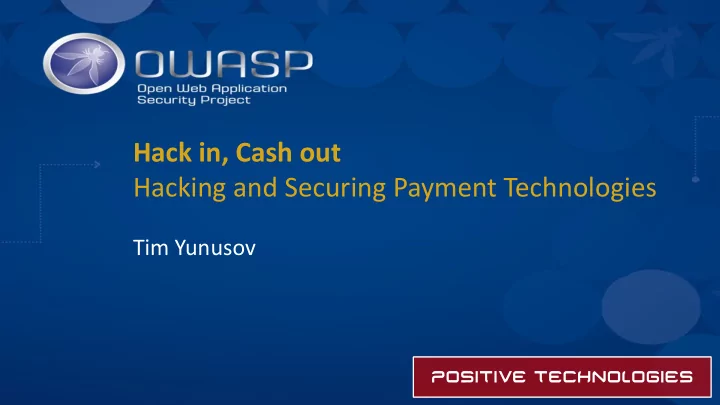

Hack in, Cash out Hacking and Securing Payment Technologies Tim Yunusov
Transaction stream fraud
Main question of the payment pentest
Good pentest Bad pentest
From our own accounts Get money from the bank
Decisions, decisions… 4 accounts in 2018 4 accounts in 2019
Card payment processing Card Endpoint Acquirer Card brands Issuer’s Authorisation host
Endpoints
@A1ex_S @groke1105 @ivachyou @L_AGalloway
https://www.terminalsimulator.com/
POS+RCE – is the instrument • EMV/NFC core real implementation • May contain a lot of bugs • Real payment process workflow • Payment packet • Configurations (limits, etc) • Offline authentication and risk management
Example of the payment packet BER encoding • TLV – Tag Length Value Example • AA0105 [hex] • Tag – AA • Length – 1 byte • Value - 05
Example of the payment packet https://tvr-decoder.appspot.com PAN/Track2/Expiry date Transaction date and time Amount and currency Type of the operation (payment, cashback, refund, other) Type of the cryptogram, cardholder verification method
Attacks • Refund/reverse attacks • Chip & PIN attacks • Card testing
Reverse attacks R e v e Auth Code r s e / A u Withdrawal t h C o d e
Refund attacks Refund Purchase Money movements Free infinite credit line Credit card Debit card
Chip & PIN is still broken • 2005 University of Cambridge, https://murdoch.is/papers/cl05chipandspin.pdf • 2010 Inverse Path (F-Secure) / Aperture Labs https://cansecwest.com/csw11/Chip%20&%20Pin%20-%20Barisani%20&%20Bianco.pdf • Intercept PIN (ICC plaintext PIN verification) • Make transactions without PIN knowledge (“PIN OK” attack) • Downgrade to chip&signature
Chip & PIN is still broken • CVM list – cardholder verification method list • CVM list is defined on the card • CVM List provides the terminal with four pieces of information on how an issuer wishes the cardholder to be verified: • CVM method (in priority) • Conditions of use • What if the CVM method is failed • Encrypted PIN if supports, then Unencrypted PIN if supports, the signature, than cancel • https://www.spotterswiki.com/emv/cardsearch.php • https://tvr-decoder.appspot.com • Offline data authentication – when POS checks that card and it’s data were genuine: SDA, DDA, CDA
When hackers come • 2011, France https://eprint.iacr.org/2015/963.pdf • 40 cards • PIN-OK additional chip • 7000 transactions • 680,000 USD
Chip & PIN is still broken • 2019, Europe • PIN interception, “PIN OK” attack, chip&signature downgrading • Why? • “Nowadays CVM is signed” (c) Inverse Path - CDA • Weak CVM Lists: PIN Online if unattended, PIN Offline elsewhere • Visa cards do not provide Offline Data Authentication • Card supports (DDA,CDA), terminal supports (DDA,CDA): • Terminal choose DDA • Terminal goes online if the offline authentication is failed
Card testing • Balance testing for stolen cards • https://www.zdnet.com/article/hackers-abuse-magento-paypal- integration-to-test-validity-of-stolen-credit-cards/
When hackers come first • Nov, 2016, 40,000 accounts, 9,000 successfully
Card testing • 1 Dec 2016, Newcastle University • https://eprint.ncl.ac.uk/file_store/production/230123/19180242-D02E-47AC-BDB3-73C22D6E1FDB.pdf • Consecutive enumeration: • BIN (public DB) • PAN (online banking registration) • Expiry Date (refund, recipient of funds) • CVV (regular payment) • Postcode for AVS (different error)
Card testing • 1 Dec 2016, Newcastle University • https://eprint.ncl.ac.uk/file_store/production/230123/19180242-D02E-47AC-BDB3-73C22D6E1FDB.pdf • Consecutive enumeration: • PAN (mobile banking registration) • Expiry Date (refund, recipient of funds) • CVV (regular payment) • Postcode for AVS (different error)
Card testing • July 2018, Monzo
Rounding 2001
Rounding • 1 GBP = 1,30 USD • 0.02 USD => float(0.0153; 2) == 0.02 GBP • 0.02 GBP => float(0.026; 2) == to 0.03 USD • Profit = 0.01 USD
Rounding • 1 GBP = 1,30 USD • 0.02 USD => float(0.0153; 2) == 0.02 GBP • 0.02 GBP => float(0.026; 2) == to 0.03 USD • Profit = 0.01 USD
Rounding • 1 GBP = 1,30 USD • 0.02 USD => float(0.0153; 2) == 0.02 GBP • 0.02 GBP => float(0.026; 2) == to 0.03 USD • Profit = 0.01 USD x10,000 • OTP bypass • Antifraud bypass • Don’t need to do everything manually
Stat • Maximum amount per project – $463,843 in 3 days (in live) • In 2019 – 8/8 banks in Europe were potentially vulnerable to rounding, one bank has confirmed the vulnerability
How to lose money during payment research • Startup, which “allows you to spend money from any of your accounts using just one * Card” - *1234 • Connect any of your cards in the mobile app • When you pay from the card *1234, money will be withdrawn from the card you’ve chosen and connected (*5678) • What if we will use Card2Card and send From *1234 To *5678 • Just a regular transaction for *5678 • We will get a cashback!
How to lose money during payment research • Send £100 • Money were withdrawn twice! • Waited 5+ days • Used 3 different card2card services • Used 3 different cards, connected in the app
How to lose money during payment research
How to lose money during payment research https://medium.com/@Tim_Y/how-to-lose-money-during-payment-research-or-in- searching-for-financial-ombudsman-5047bff89bc2
Who will pay? • Not all vendors/banks are the same • Risk-based model doesn’t care “where’s the money”, but “how much money” Bugbounty company from Google Bank “A” 1. Found vulnerability 1. Found vulnerabilitity 2. Reported with lowest CVSS/out of scope 2. Reported medium CVSS 3. Thanks, $$$ 3. It’s not been used in the wild 4. Now vulnerabilities won’t be used in the 4. Vulnerabilities still can be used wild in the wild
https://www.cardpayments.fail info (at) cardpayments (dot) fail @a66ot
Recommend
More recommend